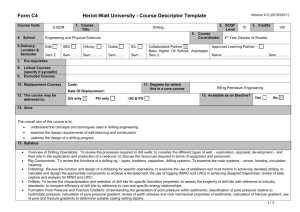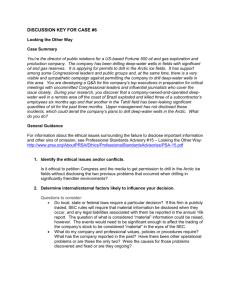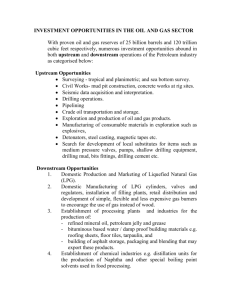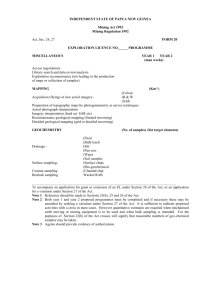Deep Investigation by Core Drilling in Mae Mo
advertisement
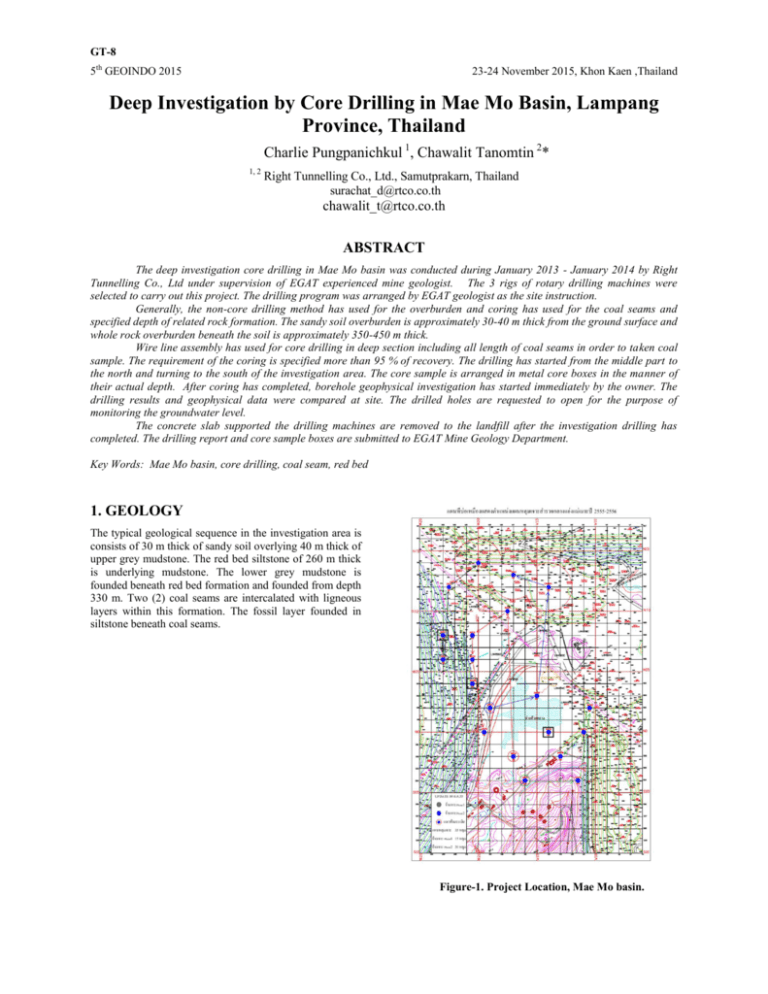
GT-8 5th GEOINDO 2015 23-24 November 2015, Khon Kaen ,Thailand Deep Investigation by Core Drilling in Mae Mo Basin, Lampang Province, Thailand Charlie Pungpanichkul 1, Chawalit Tanomtin 2* 1, 2 Right Tunnelling Co., Ltd., Samutprakarn, Thailand surachat_d@rtco.co.th chawalit_t@rtco.co.th ABSTRACT The deep investigation core drilling in Mae Mo basin was conducted during January 2013 - January 2014 by Right Tunnelling Co., Ltd under supervision of EGAT experienced mine geologist. The 3 rigs of rotary drilling machines were selected to carry out this project. The drilling program was arranged by EGAT geologist as the site instruction. Generally, the non-core drilling method has used for the overburden and coring has used for the coal seams and specified depth of related rock formation. The sandy soil overburden is approximately 30-40 m thick from the ground surface and whole rock overburden beneath the soil is approximately 350-450 m thick. Wire line assembly has used for core drilling in deep section including all length of coal seams in order to taken coal sample. The requirement of the coring is specified more than 95 % of recovery. The drilling has started from the middle part to the north and turning to the south of the investigation area. The core sample is arranged in metal core boxes in the manner of their actual depth. After coring has completed, borehole geophysical investigation has started immediately by the owner. The drilling results and geophysical data were compared at site. The drilled holes are requested to open for the purpose of monitoring the groundwater level. The concrete slab supported the drilling machines are removed to the landfill after the investigation drilling has completed. The drilling report and core sample boxes are submitted to EGAT Mine Geology Department. Key Words: Mae Mo basin, core drilling, coal seam, red bed 1. GEOLOGY The typical geological sequence in the investigation area is consists of 30 m thick of sandy soil overlying 40 m thick of upper grey mudstone. The red bed siltstone of 260 m thick is underlying mudstone. The lower grey mudstone is founded beneath red bed formation and founded from depth 330 m. Two (2) coal seams are intercalated with ligneous layers within this formation. The fossil layer founded in siltstone beneath coal seams. Figure-1. Project Location, Mae Mo basin. GT-8 5th GEOINDO 2015 23-24 November 2015, Khon Kaen ,Thailand The drill operation is closely monitoring and supervised by experienced drill foreman and site geologist. 2. DRILLING PROGRAM The HW casing is installed from ground surface to good rock strata. Non core drilling is started in sandy soil and weathered rock overburden. The hard rock overburden is drilled by wireline Triple tube core barrel with TC bit. The representative sample is selected and put into core boxes. Core Drilling is specified by client from the depth of 350450 m, above the upper coal seam about 20-30 m. The final depth is reached when drilled below lower coal seam 2-3 m or met the fossil layer in lower red bed siltstone. Table 1. Drilling Program. Formation Thickness m. 30-40 30-40 200-250 100-150 30-60 Sandy soil Mud stone Red bed Mud stone Ligneous layer & Coal Drilling Method Non cored Non cored Non cored Non cored Cored 3. MUD PROGRAM Circulation mud is prepared by mixing soda ash to raw water adjusting pH to 8 - 9.5 and then slowly put bentonite to adjusted water and added 2 chemicals into the mixture. This mixture is circulating in the storage tank at least 6-8 hrs before using. After curing, this mixture called “mud”, using as the drilling fluid. In order to take the maximum advantage of mud properties in drilling operation, the mud program is prepared. Drill mechanic are also ready in all drilling time and mechanical sense is required. The mechanical application is very important when the drilling machine has some obstructed or breakdown. The immediately decision and reparation shall be done to avoid the hole collapses due to the swelling of the red bed formation. Three (3) rotary drilling rigs are used to conducting the investigation. The maximum capacity of the drilling machines are at least 1.5-2 times of the target drilling depth. Tungsten carbide drag bits are used in soil and highly weathered rock overburden. The HQ wire line coring assembly is used for drilling in harder formation at deeper section including whole length of coal seams. This wire line assembly is help to saving the drilling time and fast enough to avoid the hole collapsing. The drill rig should be setting on the stable ground during drilling operation. The concrete slab is proposed to use. The 20 cm thick of concrete slab is constructed after compact the original ground surface. The drilling machine has tied to the concrete by steel wire to fix it and avoids the movement when pulling drill rods up and prevent hole deviation. According to drilling in different rock formation, the mud should be prepared in different properties. This mud program is used in the deep investigation in Mae Mo basin. Table 2. Mud Program. Formation Unconsolidated sediments/loss circulation (0-60 m) Swelling Mudstone (60-320 m) Coal Seam (> 320 m) Viscosity 40-45 40-45 45-50 Ingredient Water: 565 L Soda ash: 1.0 kg Bent: 75 kg DFC: 1.5 kg Water: 2,449 L Soda ash: 2.5 kg Bent: 200 kg DFC: 4.5kg CRP: 3 kg Water: 2,637 L Soda ash: 2.5 kg Bent: 225 kg DFC: 5 kg CRP: 3.25 kg Figure 2. Concrete slab for supported drill rig. Figure 3. Rig Installation on Concrete Slab. 4. DRILLING PREPARATION Drilling Crews are enough experiences to conducting the core drilling, especially the driller. More than 10 years experience drillers are adopted to operate the deep drilling. GT-8 5th GEOINDO 2015 23-24 November 2015, Khon Kaen ,Thailand 6. DRILLING PROCEDURE The drilling is started by installation of HW casing in the soil overburden. The casing is proposed to install as less as possible. In deep installation of the casing should remove it out immediately after drilling completed or before 1-2 days after installed because the skin friction between the swelled red bed formation and casing surface developed shall against the pulling force. This skin friction may increase up to 0.5 ton/m, at this load the casing can’t take and the rupture of casing is resulted. The best way is use casing as necessary as possible. Figure 4. Preparation of wire line core barrel. Figure 5. Core extruding. Figure 7. Casing installation. The non-core drilling should continue below the casing end by drag bit and TC cored bit. The non core drilling is continue until reached around 20-50 m above the upper coal seam, then change to core drilling until completed to target depth. Figure 6. Coal Sample. 5. ROLE OF DRILLING FLUID The mixture of water, bentonite and additive chemicals, called mud, were used as drilling fluid for whole length of drilling operation. The mud is very important when drilling at deep section. It’s help to cooling and lubricating the drill bit and drill rod from abrasion of wall rock. The drill cutting have transported from bottom of the hole to the hole collar by mud circulation. According to circulation of the mud, it forming mud cake at the hole wall to protecting the hole collapse and circulation loss. Figure 8. Non- core samples from overburden. GT-8 5th GEOINDO 2015 23-24 November 2015, Khon Kaen ,Thailand logging are not allowed. Coal samples were brought to laboratory for chemical properties testing. Figure 9. Core samples. The drilling revolution used is rather low when using drag bit due to drill rods shank and become higher when conduct core drilling. Normally, the revolution used in drilling with TC bit is between 150-300 RPM and the circulation of drilling fluid is about 11 GPM or 42 LPM. The WOB is not specified, applied up on the rock formation. Too much WOB should induced clogging at the drill bit. The pressure of circulation fluid should be controlled. Too high circulation pressure should increase the up hole velocity but also induced hole collapse. The adjusting of these factors is very important and should effect to drilling rate and may lead to some drilling problems. Figure 11. Coal sample. 9. SITE REMEDIAL When the investigation drilling has completed without any suspecting, the site remedial is required to its original. The concrete slab should be removed by hydraulic jacking and transport concrete to the permitted landfill. The drilled hole after remove casing is leave to open for monitoring the groundwater depth as long as possible. Some casing and drill rods that obstructed in drilled hole should be noted and inform to the client because they effecting to the excavation. 7. GEOPHYSICAL SURVEY The borehole geophysical investigation is immediately starting after the drilling has completed. The gamma ray logging, density and ATV survey are conducted by EGAT, Geophysical Section. The interpretation of geophysical logging data should be done at site and compare to the core samples at whole depth. The conflict of results should be solved by re-surveying until founded the conclusion. Figure 12. Site Re-habitation. 10. CONCLUSION Figure 10: Borehole geophysical survey 8. CORE SAMPLE All core samples from drilled holes are arranging to actual depth in metal core boxes, wrapped by plastic sheet and submit to EGAT, Mine Geology Section. The photos and Deep investigation by non-core and core drilling has conducted at the middle area in Mae Mo basin. The investigation is carrying by 3 rotary drilling machines. These investigation depths are between 400-600 m from existing ground surface. There are founded 2 coal seams from depth of 400-550 m. The core drilling fluid is used GT-8 5th GEOINDO 2015 bentonite with 2 chemicals mixing to adjust it properties to meet the requirement. The total of 10,010 m was drilled consisting of non-core drilling 7,176 m and core drilling of 2,834 m. The average total drilling rate is approximately 35 m/day. The drilling in red bed formation is hardest due to its swell property. The major problems during drill operation are hole collapse and circulation loss especially in coal seams at the deepest depth. The drilling machine and equipment condition, experiences of drilling crews and drilling method are the most important. The project completion is reached by cooperation of site geologist, driller, drill assistants, drill mechanic and drill supervisor. 11. REFERENCES Rotary Drilling Accessories Catalogue, Boart Long Year. Horizontal Directional Drilling Information Guideline, Drilling Fluid, Straightline, 2006. Formulas and Calculations for Drilling Production and Work Over, Norton J. Lapeyrouse, Elsevier Science, 2002. Closure Report of the Mae Mo Investigation Project, Right Tunnelling Co., Ltd, 2014. 23-24 November 2015, Khon Kaen ,Thailand



